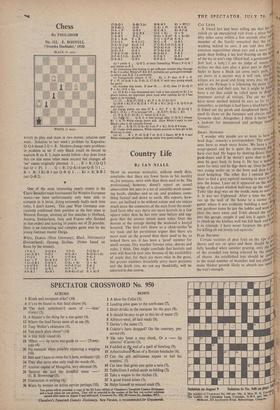Chess
By PHILIDOR No, 112. E. BOSWELL ('Svenska Daebladet,' 1928)
ot.aca (4 men)
WHITE (3 men)
witrre to play and mate in two moves: solution next week. Solution to last week's problem by Kapralos: Q-Q 6 threat 2 Q x B. Modern change mate problem: in position as set if only Black could be forced to capture B on K 5, mate would follow-key does force this (or else some other mate occurs) but changes all 'set' mates originally planned. 1 . . . R x B; 2 Q-Q 5 (set Q x P). 1 • . Q x B; 2 Q.-Kt 6 (set Q-R 7) 1 ... B x B; 2 Kt-B 3 (set Q-B 4) 1 ... Kt x B; B-B 2 (set Q-B 2).
One of the most interesting yearly events is the Claire Benedict team tournament for Western European teams-we have unfortunately only been able to compete in it twice, doing extremely badly each time (why, I don't know). This year West Germany con- clusively confirmed their position as the best team in Western Europe, winning all five matches (v Holland, Austria, Switzerland, Italy and France who finished in that order) and scoring 16 points out of 20 possible. Here is an interesting and complex game won by the young German master Darga.
White, DAIWA (West Germany); Black, NIEVEECIELT (Switzerland); Opening, Sicilian. (Notes based on those by the winner).
1 P-K 4 P-Q B 4 9 0-0
P-Q Kt 4
2 Kt-K B 3 P-Q 3 10 K-R 1
R-Q Kt 1 (6)
3 P-Q 4 P x P 11 P-B 4 P-Kt 5 4 Kt x P 1(1-1( 03 12 P x P R x P 5 K(-Q 13 3 P-Q R 3 13 Kt x Kt Q x Kt 6 11-0 04
P-K 3 (a) 14 P-B 5! (c)
0-1(2
7 P-Q R 3
Q-92 15 P x P P x P 813-B 2 Kt-B3
16 B-Kt-5I (d) R X Kt P 17 Q-4!) 3. R-Kt 2 (a) 30 R-13 3 Kt x B? (I)
18 B-Kt 3 0-0 31 Kt X PI Q-R 8 ch 19 R x P ' Q-B 4 . 32 K-R 2 Kt-B 8 ch 20 11-1C 3 Q-K R 4 33,R x Kt Q x R
21 R-R 8 B-Q 2 . 34 Kt x B ch/ K x Kt (k) '
22RxRch BxR 35 Q x Q P ch K-K 1
23 B-Q 4 R-B 2 (j) 36 Q x R Q-B 3 . 24 Kt-K 2 (g) Kt-K 1-5 37 Q-Kt 8 ch (I)K-K 2
25 Q-Kt 3 KtAC. 4 38 Q-Kt 4 ch K-K 1 26 K I3 4 Q R 3 39 Q-Kt 8 ch K-K 2
27 B-K 31(h) Q-B 3 40 Q-Kt 3 P-R 3
28 P-R 3 3 (I) Kt-B 5 41 P-KSQ-
29 R-B 2 Q-B 6 42 P-K 6 Resigns (m) (a) I prefer 6.- Q-B 2; at once forestalling White's P-Q R 3 and retreat to R 2.
(b) Interesting idea hoping to get sufficient counter play through P-Kt 5 to offset White's P-B 4-B5; probably not quite good enough in which case B-K 2 is preferable.
(c) Energetically played: if 14 . . . Kt x P; then 15 P x P. P x P; 16 Q-R 5 ch, P-Kt 3; 17 Q-R 31 with very strong attack for pawn.
(d) Another fine move. If now 16 . . . 0-0; then 17 Kt-Q 5! P x Kt; 18 B x Kt.
(e) 18 13-Kt 3 was threatened and rook is best placed on Kt 2 to guard bishop, an important point since after castling Kt-Q 5 has again to be watched.
( i ) 23 ... B-K 2?; 24 13 x Kt. P x B; 25 Kt-Q 51 (g)24 B x Kt. P x B; 25 R x P1, R x Ku; 26 Q x ft, Q-Q 8 ch and mates.
(k) Oarga points out that 27 B x Kt!, P x B; 28 Kt-Q 3. B-Q 3; 29 Kt x Pt is stronger (29 ... R-B 4?'); 30 Kt x Bl) (1) 28 ft-B 21, Kt-Kt 5!, threat Q-R 8 ch.
(I) Fab 30. .. Q-K 4; is best though after 31 Q-B 2 (threat Kt x K P) White stands better still. After White's reply to text Black's play is all virtually forced. (k) 34... K-R 1?; 35 Kt-Kt 6 ch, P x Kt; 36 Q-R 4 mate.
(/) Under clock pressure, White repeats position to help get in his 40 moves in time.
(m) 42. . . B x Pi 43 Q-B 7 ch, B-Q 2 (best); 44 B-R 4 and White exchanges all pieces with an easily won pawn ending.






























 Previous page
Previous page